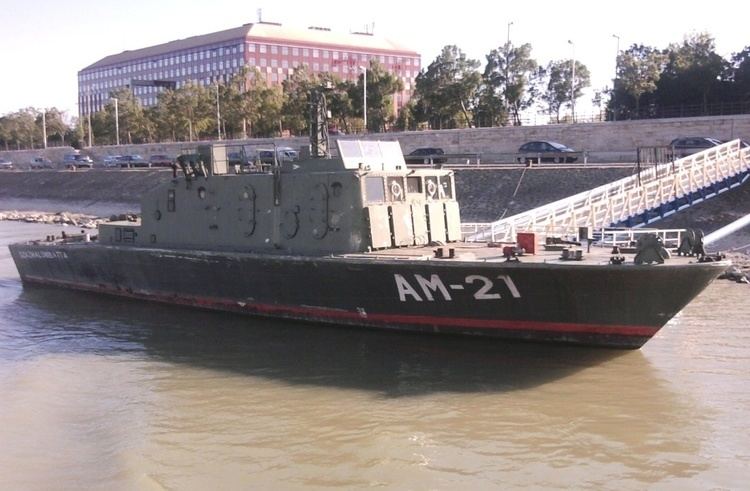A landlocked navy is a naval force operated by a country which does not have a coastline. While such states are obviously unable to develop a sea-going, blue-water navy, they may still deploy armed forces on major lakes or rivers.
There are a number of reasons a landlocked country may choose to maintain a navy. If a river or lake forms a national border, countries may feel the need to protect and patrol that border with a military force. In some regions, roads may be unreliable or circuitous, and a river or lake may be the easiest way to move military forces around the country. Sometimes, possession of a body of water may actually be contested – for example, countries around the landlocked Caspian Sea have different views of how ownership should be divided.
Patrol boats of various types are the most common craft among landlocked navies. Some landlocked navies possess troop or vehicle transports, allowing ground forces to cross or travel along a lake or river.
Landlocked countries that have navies today include:
Azerbaijan – although Azerbaijan borders the Caspian Sea, the Caspian Sea does not connect to the ocean by natural waterway – by some definitions, this makes the country landlocked. The Azerbaijani Navy operates on the Caspian Sea. In 2003, Russia's Volga-Don Canal was used to deliver a cutter gifted by the US Government to the Azerbaijani Navy.Bolivia – Bolivia lost access to the Pacific Ocean during the 1879 War of the Pacific. In 1963, the Bolivian government established a riverine and lacustrine force (Fuerza Fluvial y Lacustre) to patrol Lake Titicaca and Bolivia's larger rivers, consisting of four American-purchased patrol boats and 1,800 personnel recruited from the army. This naval force, renamed Bolivian Naval Force in 1966, reached a strength of 5,000 personnel in 2008. It also had a naval unit permanently deployed in the Argentine city of Rosario. To some Bolivians, the Navy serves as a symbol that the country has not given up on regaining its lost access to the sea.Central African Republic – a small naval force is maintained on the Ubangi River, a tributary of the Congo River. The Ubangi River forms the country's border with the Democratic Republic of Congo and is a significant transport route.Kazakhstan, Turkmenistan – although both countries border the Caspian Sea, the Caspian does not connect to the ocean by natural waterway – by some definitions, this makes the two countries landlocked. Both Kazakhstan and Turkmenistan operate a small navy on the Caspian Sea.Laos – the Lao People's Navy operates vessels on the Mekong River, a major feature of the country's geography. It is believed to operate two or three dozen small patrol boats. Because the Mekong makes up a considerable portion of the Laotian border, the Navy is significantly involved in border control work.Mongolia - with a single vessel and a strength of seven.Paraguay – the Paraguayan military operates a navy of around a dozen vessels and has several thousand personnel. It operates on the country's major rivers, notably the Paraguay River and the Paraná River. The Paraguayan navy could reach the open sea by traveling downriver through Argentina. The Paraguayan Navy served in the Paraguayan War and in the Chaco War.Rwanda – a small navy patrols Lake Kivu, between Rwanda and the Democratic Republic of Congo. It was involved in the Second Congo War.Uganda – the Uganda People's Defence Force Marine Wing operates on Lake Victoria.Other countries may operate water-based military forces without actually establishing an independent navy—instead, responsibility may be given to a branch of a different service, often the army.
Examples of landlocked countries which do this include:
Burundi – on Lake Tanganyika.Ethiopia – Ethiopia established a navy in 1955 but became a landlocked country upon the independence of Eritrea in 1991. Despite this, the Ethiopian Navy survived until 1996, operating from foreign ports. Today, the Ethiopian Army operates a single boat on Lake Tana.Hungary – has one of the heaviest and most qualified warship battalion in East-Central Europe; only Hungary operates river-based military forces of the surrounding NATO-members with the exception of Romania. The Home Defence Pyrotechnician and Warship Battalion of the Hungarian Defence Forces based in Újpest Port, on the River Danube, Budapest. In the 2000s, the army bought new minesweepers, restored or retired the old ones. On national holidays warships come along the River Danube in Budapest.Malawi – on Lake Malawi.Mali – maintains a small riverine patrol force as part of the army.Serbia – the Serbian Army operates a river flotilla consisting of: minesweepers, patrol boats, and landing craft on the Danube, Tisza and Sava rivers.Switzerland – The Swiss Armed Forces operate Aquarius-class patrol boats on Lake Geneva, Lake Maggiore, Lake Lucerne, Lake Lugano and Lake Constance. The small vessels are manned by the 10th Motorboat Company of the Engineers Corps.Uzbekistan - operates gunboats and other riverine craft on the Amu Darya under its Frontier Service.Lacustrine, riverine and landlocked naval elements of non-landlocked countries
Naturally, the operation of military forces in lakes and rivers is not limited to landlocked countries. Many states maintain such forces (e.g., Russia's Caspian Flotilla) in addition to their seagoing navy. River-based forces are often referred to as brown-water navies, and may or may not be part of the same organisation as the seagoing navy.

